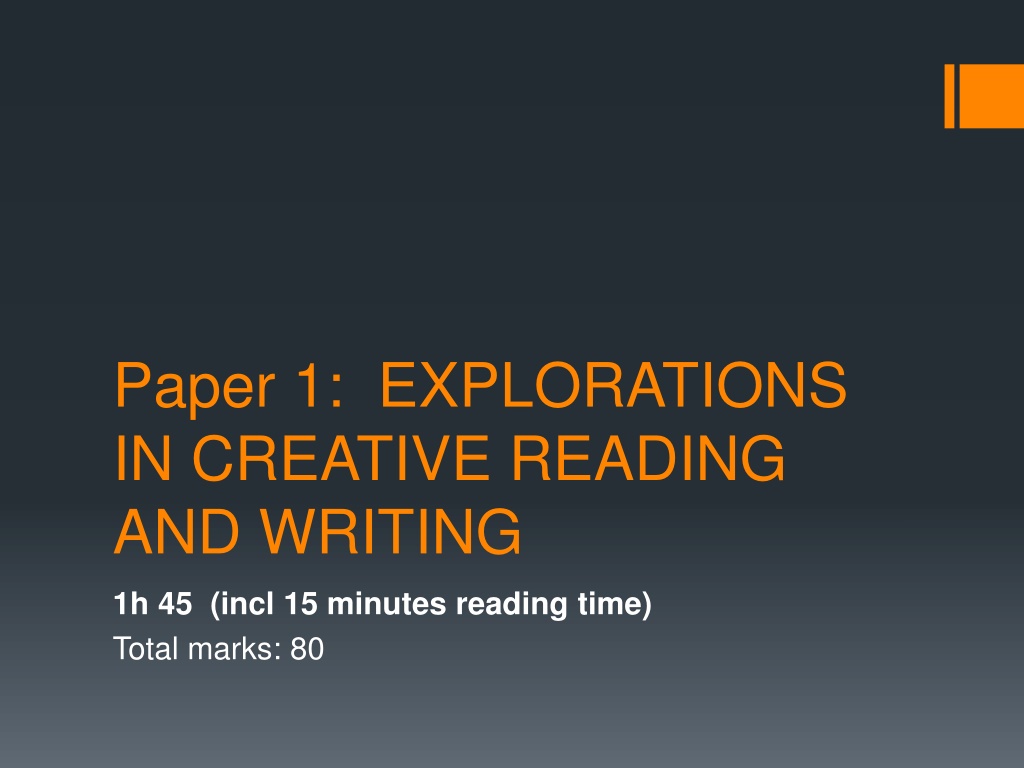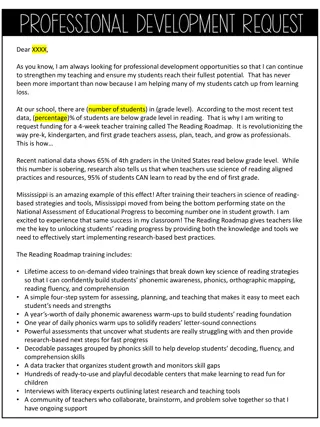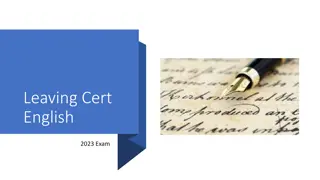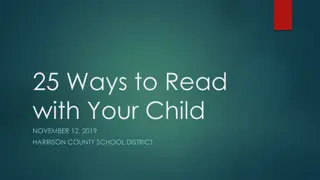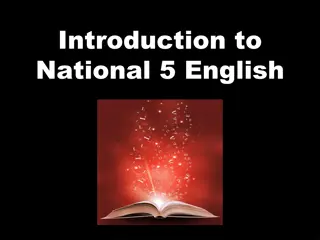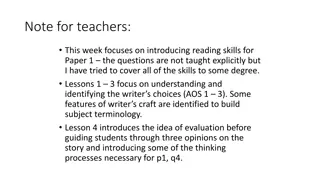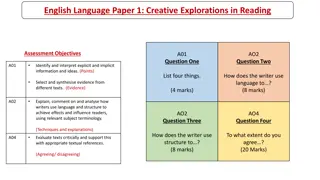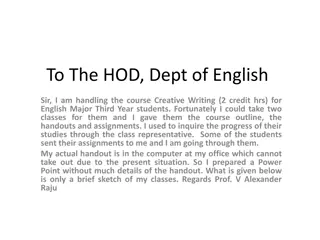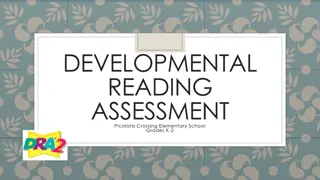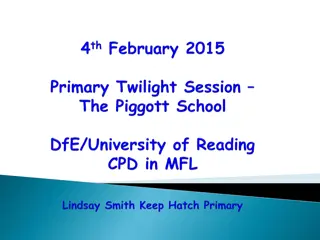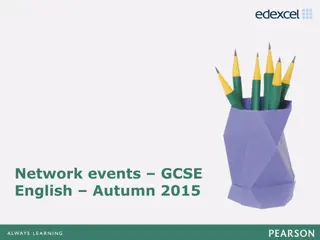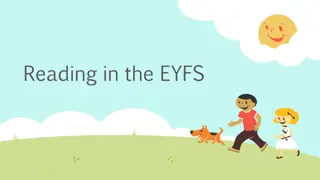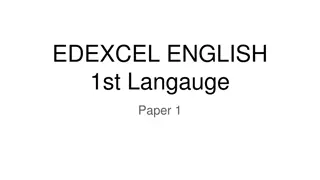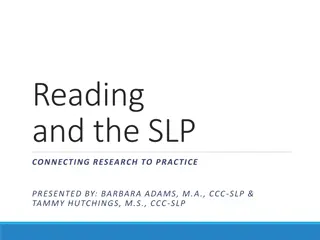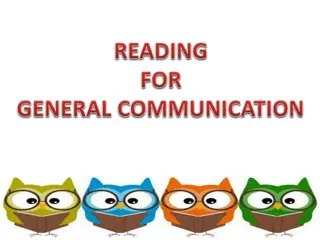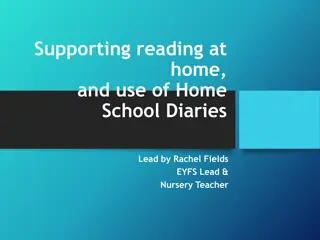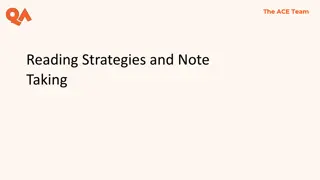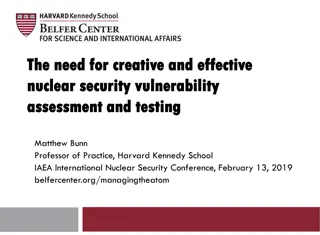Explorations in Creative Reading and Writing Assessment Overview
The assessment paper provides detailed instructions and guidelines for students on how to approach creative reading and writing tasks. It outlines the structure of the exam, timing, and marks allocation for each section. Students are required to engage with literary texts, analyze language use, structure, and themes, and demonstrate their creative writing skills through narrative or descriptive writing. Key vocabulary terms and example source text are also included to aid students in understanding and interpreting the material effectively.
Download Presentation

Please find below an Image/Link to download the presentation.
The content on the website is provided AS IS for your information and personal use only. It may not be sold, licensed, or shared on other websites without obtaining consent from the author. Download presentation by click this link. If you encounter any issues during the download, it is possible that the publisher has removed the file from their server.
E N D
Presentation Transcript
Paper 1: EXPLORATIONS IN CREATIVE READING AND WRITING 1h 45 (incl 15 minutes reading time) Total marks: 80
Timings and marks SECTION A Question Q1: List four things Marks (4) Writing Time 5 minutes Q2 How does the writer use language to (8) 9 minutes Q3 How has writer structured the text to (8) 9 minutes Q4 To what extent do you agree with [statement] (20) 22 minutes SECTION B Question Q5 creative writing : narrative and/or descriptive writing skills 40 marks for writing (25% of total GCSE) 24 (AO5 content)+16 (AO6 SPaG) marks 45 minutes
Section A Structure ONE single 20thor 21stC literature prose fiction source eg. novel / short story extract AO1 Identify and interpret explicit and implicit information and ideas. Select and synthesise evidence from different texts. AO2 Explain, comment on and analyse how writers use language and structure to achieve effects and influence readers, using relevant subject terminology to support their views. Compare writers ideas and perspectives, as well as how these are conveyed, across two or more texts. (only on paper 2) Evaluate texts critically and support this with appropriate textual references. AO3 AO4
Section B Structure Either write a description suggested by picture OR write opening to a story about . AO5 Communicate clearly, effectively and imaginatively, selecting and adapting tone, style and register for different forms, purposes and audiences. Organise information and ideas, using structural and grammatical features to support coherence and cohesion of texts. Students must use a range of vocabulary and sentence structures for clarity, purpose and effect, with accurate spelling and punctuation. (This requirement must constitute 20% of the marks for each specification as a whole). AO6
KEY VOCABULARY Explicit: directly expressed Implicit: suggested though not directly expressed Synthesise: to make meaning of something Question 1: 4 marks Read again the first part of the Source from lines 1 to 5. List four things about Mr Evans from this part of the Source. AO1 Identify and interpret explicit and implicit information and ideas. Select and synthesise evidence from different texts.
Example Source A: It is war-time and Carrie and her brother Nick have been sent away from their home in London, as evacuees1, to live in the safety of a village in Wales with Mr Evans and his sister. Here, after their first night, they meet Mr Evans. He wasn't an Ogre2, of course. Just a tall, thin, cross man with a loud voice, pale, staring, pop-eyes, and tufts of spiky hair sticking out from each nostril. Councillor Samuel Isaac Evans was a bully. He bullied his sister. He even bullied the women who came into his shop, selling them things they didn't really want to buy and refusing to stock things that they did. 'Take it or leave it,' he'd say. 'Don't you know there's a war on?"
Answers students may include: he wasn t an ogre he was tall he was thin he was a cross man he had a loud voice he had pale / staring / pop-eyes he had tufts of spiky hair sticking out from each nostril he was a councillor he had a sister / which he bullied he bullied his customers.
Tips Use a highlighter to spot words and phrases in the source Ensure you only select from the specified lines. Read the source carefully it may not be what you first thought! If time, check your answers Do not spend more than 5 minutes on this question
Question 2: 8 marks Look in detail at this extract from lines 6 to 12 of the Source. (Extract in question paper) How does the writer use language here to show us what Nick felt about being frightened? You could include the writer s choice of: words and phrases language features and techniques sentence forms. AO2 Explain, comment on and analyse how writers use language and structure to achieve effects and influence readers, using relevant subject terminology to support their views
What do they mean by language? Words : nouns/verbs/adjectives/adverbs/conjunctions/prepositions Phrases: noun phrases/adjectival phrases Language Features: word choice/tone/style/structure Language Techniques: CRAPFOREST Sentence Forms: simple/compound/complex
Level 4: Perceptive, Detailed analysis Level 4 answer The writer emphasises the things Nick actually is afraid of by using the device of a list of nouns which includes alliteration: Ogres and spiders and crabs and cold water and the dentist and dark nights . The repetition of the conjunction and further emphasises the individual fears but also develops the cumulative effect of all of them together. The varied list of fears helps to encompass most readers because they range from fantasy Ogres , to creepy-crawlies, to the commonplace dentist and dark nights . The compound sentence is then balanced by the phrase that stresses the word but in, but he wasn t often afraid of people . This juxtaposition, containing the emphasis wasn t often and the noun people put Nick s feelings for Mr Evans, as no threat, into perspective.
Level 4: simple, limited, comment Level 1 answer It says that Nick was frightened of Ogres and spiders which emphasises that there are horrible things Nick was frightened of, but he wasn t frightened of people like Mr Evans.
Tips Highlight anything interesting as you read, try to cover words, phrases, techniques, sentence structure, punctuation Comment on language in the lines specified Use PEE+E to ensure top level analysis Closely analyse language: literal meaning and implied meaning
Question 3: 8 marks You now need to think about the whole of the Source. This text is from a novel and describes the first meeting of the main characters. How has the writer structured the text to interest you as a reader? You could write about: what the writer focuses your attention on at the beginning how and why the writer changes the focus as the Source develops any other structural features that you think help to develop the meeting. AO2 [ Explain, comment on and analyse how writers use language and structure to achieve effects and influence readers, using relevant subject terminology to support their views
What structural features have been included in this answer? Level 4 answer The text begins with a wide, general focus about what Mr Evans is like and how he treats people; it includes mention of his shop which is a different place to the breakfast room. Then we shift to Nick and his thoughts about what frightens him, and what doesn t (including Mr Evans). Mr Evans and Nick then combine in the tense dialogue between them, during which the writer focuses down to Mr Evans mouth: Nick s gaze was fixed on Mr Evans mouth and the humour associated with his clicking false teeth. This acts as a structural feature to add humour because it keeps focussing the reader on his teeth. It is a thread repeated to undermine him as a comic character. The next structural effect is the pause, Silence fell when Mr Evans leaves the room; the tension subsides, Carrie and Miss Evans come to the fore.
Level 1 answer The text is written in paragraphs which makes it easy to read. It starts with Mr Evans and what he is like, then brings in Carrie and Nick and how they react to Mr Evans.
Tips Highlight structural features Cover the whole text Discuss effect Use PEE+E to help keep you on track
Key word: Evaluate: form an idea abut the value of something, in this case whether you agree or disagree. Question 4: 20 marks Focus this part of your answer on the second half of the Source from line 13 to the end. A teacher, having read this section of the text said: I like how the writer helps my students to feel involved in this moment. It is as if they are in the room with the characters. To what extent do you agree? In your response, you could: consider your own impressions of the characters evaluate how the writer helps you to feel involved support your response with references to the text. AO4 Evaluate texts critically and support this with appropriate textual references
Level 4 answer I can see why a teacher might have said what he has because, as a student, I too feel as if I am in the room with the characters. The writer has created a hero in the young Nick; a David taking on the Goliath of the bullying and self-centred Mr Evans. The writer achieves this partly by having Nick challenge and better Mr Evans verbally; partly by Nick establishing his (and Carrie s) social superiority through his heroic father: A Naval Officer, Captain Peter Willow and partly through humour: the focus on Mr Evans clicking false teeth. This school-boy motif recurs throughout You can t really be scared of someone whose teeth might fall out , ..bared those loose teeth , Nick s gaze was fixed on Mr Evans mouth , Mr Evans teeth clicked-to attention perhaps . The effect on the reader in the exchanges between these two characters is to juxtapose fear and tension with humour and relief. The ultimate victor is Nick; the defeated Mr Evans backs off to the delight of the reader.
Level 3 answer I agree. The writer creates tension in the room with the stand- off between Mr Evans and Nick. The wittering, moaning, bullying Mr Evans who suggests having the children to stay is a bitter pill to swallow, is ignorant and clueless about children. This alienates the reader, but this is balanced by the character of Nick. He is shown to be more clever, better behaved and braver than the bully. Nick shows his superiority with Even my father doesn t swear and he s a Naval Officer . The effect is that Mr Evans leaves the room to the amusement of the reader.
Level 1 answer I agree in that the characters are good because you can see what they are like. Mr Evans seems to be cross and fussy. The writer makes him seem nasty to the children but Nick stands up to him, which is funny in parts. What are the differences between these answers?
Tips Focus only on the section you have been asked to write about. Identify why you agree with the statement (even if you don t, you are expected to!) Focus on what you are being asked to evaluate: e.g. how involved you are with the characters Use PEE+E to keep you on track Refer to the question at the beginning of your answer.
Question 5:40 marks (24 marks for content and organisation 16 marks for accuracy) Your teacher wants you to contribute to a collection of creative writing. She will judge which pieces can go into the collection. Either: Write a description of young children leaving home as suggested by this picture: (picture of child evacuees at a train station) Or: Write a description about a person who has made a strong impression on you.
Level 4 criteria Content Register is convincing and compelling for audience Assuredly matched to purpose Extensive and ambitious vocabulary with sustained crafting of linguistic devices Organisation Varied and inventive use of structural features Writing is compelling, incorporating a range of convincing and complex ideas Fluently linked paragraphs with seamlessly integrated discourse markers
Level 4 SPaG criteria Sentence demarcation is consistently secure and consistently accurate Wide range of punctuation is used with a high level of accuracy Uses a full range of appropriate sentence forms for effect Uses Standard English consistently and appropriately with secure control of complex grammatical structures High level of accuracy in spelling, including ambitious vocabulary Extensive and ambitious use of vocabulary
Tips Identify the TAP of what you have been asked to write Decide on the appropriate tone Plan your ideas and order your paragraphs Consider which language techniques and features you will use (techniques to describe) Leave time to check your answer for mistakes and remove repeated words Use synonyms for bad/good etc.
